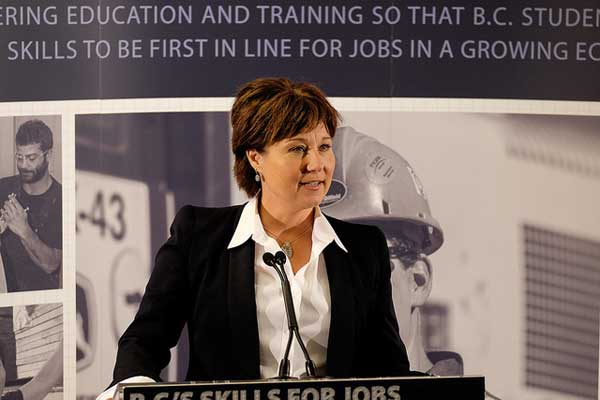In the three years since Premier Christy Clark announced the B.C. Jobs Plan in September 2011, the number of jobs has grown half as fast as it did over the previous decade.
Released yesterday, a glossy three-year update on the plan says on page 3, "Since 2001, total employment in the province has increased by 20.2 per cent, adding more than 388,000 new jobs." It adds, "Since the B.C. Jobs Plan launch, the province has added more than 50,000 jobs."
While it might seem odd to try to demonstrate the plan's success by quoting figures going back a decade before the plan was announced, crunching the numbers shows why the government must have been tempted -- though a Jobs Ministry spokesperson insisted the figures were used for context.
Based on the government's figures, some 33,800 jobs were created on average each year between 2001 and 2011. In the three years since the 2011 announcement, growth in the number of jobs has averaged 16,700 a year.
The report, which Jobs, Tourism and Skills Training Minister Shirley Bond released while touring a Vancouver salt business, argues job growth needs to be assessed over time, not month to month, and that the government has laid the foundation for economic growth.
Jobs Plan a failure: NDP
The report made an easy target for Shane Simpson, the NDP's critic for economic development, jobs, labour and skills. "Today was an attempt on the part of the minister to mask the dismal failure of the Jobs Plan," he said. "It's been a failure no matter how you look at it."
Since the plan was launched, B.C. has been the second worst in the country for job growth in the private sector, and the third worst for wage growth, he said.
He noted that in various sections the government's report picks different starting dates, at times measuring from 2001, 2009 or 2011. "You have them putting out a plan that can't pick a date," he said. "I think it's trying to mask the reality this plan has failed."
Several sections discuss economic growth rather than job creation, Simpson noted. "There was a time when they were pretty closely linked," he said. Investment in the province no longer automatically translates into jobs, he said. "We're seeing a whole lot of economic growth now without jobs attached to it."
With the legislature returning Oct. 6, Simpson said there's need for a discussion about how to make the Jobs Plan successful. He pointed to the need for more skills training and requirements to have more apprentices on publicly funded projects.
Who's working where?
The B.C. Jobs Plan highlighted eight areas of the economy where the government plans to focus on expanding markets and creating jobs: agrifoods, forestry, mining, natural gas, international education, transportation, tourism and technology.
The report cites figures for how many people are working in each sector, adding up to a total of 506,000, plus the potential for 100,000 jobs in natural gas and another 100,000 prospective jobs in tourism.
It failed to examine how the number of people working in each sector may have changed since 2011.
Statistics Canada provides monthly figures based on the North American Industry Classification System. The categories are not exactly the same as the ones the BC Liberals use, but give some idea of how many people are working in various sectors. They are current up until August 2014.
According to Statistics Canada, using seasonally unadjusted figures, since September 2011 B.C. gained 4,200 jobs in forestry and logging, 5,900 in mining, quarrying and oil and gas extraction, and 27,500 in transportation and warehousing.
Over the same period, the province lost 1,500 jobs in agriculture, 1,100 in accommodation and food services and 35,600 in educational services.
Relatively large changes outside the B.C. Jobs Plan's areas of focus included a gain of 16,600 in public administration, and losses of 12,300 in construction, 19,400 in retail trade and 11,000 in real estate and leasing.
According to the NDP, the roughly 50,000 jobs gained since September 2011 included just 2,800 in the private sector and over the same period the province's working age population grew by 123,500. ![]()
Read more: Local Economy, Labour + Industry, BC Politics
















Tyee Commenting Guidelines
Comments that violate guidelines risk being deleted, and violations may result in a temporary or permanent user ban. Maintain the spirit of good conversation to stay in the discussion.
*Please note The Tyee is not a forum for spreading misinformation about COVID-19, denying its existence or minimizing its risk to public health.
Do:
Do not: